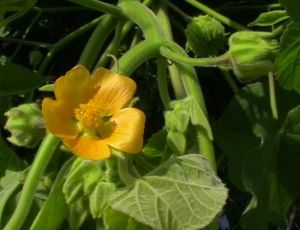China Jute
Abutilon theophrasti (Velvetleaf, China Jute, Buttonweed, Butterprint, Pie-marker, or Indian Mallow) is an annual plant in the family Malvaceae, native to southern Asia. Its specific epithet theophrasti commemorates the ancient Greek botanist-philosopher Theophrastus.


Description
It grows to 1 m tall, and has velvet-like heart-shaped leaves 15–25 cm broad. The flowers are yellow or orange, 4 cm diameter, maturing into button-shaped capsules which split lengthwise to release the seeds. The flowers and plants have a fruity scent.
Velvetleaf grows as a weed primarily in cropland, especially corn fields, and it can also be found on roadsides and in gardens. Velvetleaf prefers rich and cultivated soils, such as those used in agriculture.
Cultivation and uses
Velvetleaf has been grown in China since around 2000 BCE for its strong, jute-like fibre. The leaves are edible, stir-fried or in omelette. The plant is known as maabulha in the Maldives and its leaves were part of the traditional Maldivian cuisine, usually finely chopped and mixed with Maldive fish and grated coconut in a dish known as mas huni. The seeds are eaten in China and Kashmir.
Fresh leaves are described as bitter. Thawed frozen jute tastes spinachy and grassy but mild. It is mucilaginous (similar to Malabar spinach) and has an extremely slippery texture.
Health Benefits of China Jute
Jute leaf contains vitamins A, B6 and C, calcium, copper, folate, iron, manganese, magnesium, niacin, potassium, thiamin and zinc. Jute contains mucilage, considered a detoxifying agent as well as a rich source of soluble fiber.
Invasive species
In midwestern and northeastern regions of the United States, eastern Canada and the Eastern Mediterranean, A. theophrasti is considered a damaging weed to agricultural crops, especially corn and soybeans. Velvetleaf is an extremely competitive plant, so much so that it can steal nutrients and water from crops. Velvetleaf is controllable by herbicides.

